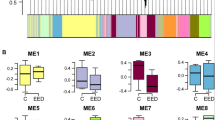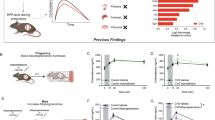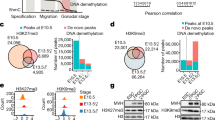Abstract
The timing of puberty is controlled by many genes. The elements coordinating this process have not, however, been identified. Here we show that an epigenetic mechanism of transcriptional repression times the initiation of female puberty in rats. We identify silencers of the Polycomb group (PcG) as principal contributors to this mechanism and show that PcG proteins repress Kiss1, a puberty-activating gene. Hypothalamic expression of two key PcG genes, Eed and Cbx7, decreased and methylation of their promoters increased before puberty. Inhibiting DNA methylation blocked both events and resulted in pubertal failure. The pubertal increase in Kiss1 expression was accompanied by EED loss from the Kiss1 promoter and enrichment of histone H3 modifications associated with gene activation. Preventing the eviction of EED from the Kiss1 promoter disrupted pulsatile gonadotropin-releasing hormone release, delayed puberty and compromised fecundity. Our results identify epigenetic silencing as a mechanism underlying the neuroendocrine control of female puberty.
This is a preview of subscription content, access via your institution
Access options
Subscribe to this journal
Receive 12 print issues and online access
$209.00 per year
only $17.42 per issue
Buy this article
- Purchase on Springer Link
- Instant access to full article PDF
Prices may be subject to local taxes which are calculated during checkout








Similar content being viewed by others
Accession codes
Primary accessions
Gene Expression Omnibus
Referenced accessions
NCBI Reference Sequence
References
Plant, T.M. & Witchel, S.F. Puberty in nonhuman primates and humans. in The Physiology of Reproduction 3rd edn. (ed. Neill, J.D.) 2177–2230 (Academic/Elsevier, San Diego, 2006).
Ojeda, S.R. & Skinner, M.K. Puberty in the rat. in The Physiology of Reproduction 3rd edn. (ed. Neill, J.D.) 2061–2126 (Academic/Elsevier, San Diego, 2006).
Kordon, C., Drouva, S.V., Martínez de la Escalera, G. & Weiner, R.I. Role of classic and peptide neuromediators in the neuroendocrine regulation of luteinizing hormone and prolactin. in The Physiology of Reproduction 2nd edn., Vol. 1 (eds. Knobil, E. & Neill, J.D.) 1621–1681 (Raven, New York, 1994).
Ojeda, S.R., Lomniczi, A. & Sandau, U. Contribution of glial-neuronal interactions to the neuroendocrine control of female puberty. Eur. J. Neurosci. 32, 2003–2010 (2010).
Messager, S. et al. Kisspeptin directly stimulates gonadotropin-releasing hormone release via G protein-coupled receptor 54. Proc. Natl. Acad. Sci. USA 102, 1761–1766 (2005).
Suter, K.J. Control of firing by small (S)-α-amino-3-hydroxy-5-methyl-isoxazolepropionic acid-like inputs in hypothalamic gonadotropin releasing-hormone (GnRH) neurons. Neuroscience 128, 443–450 (2004).
Iremonger, K.J., Constantin, S., Liu, X. & Herbison, A.E. Glutamate regulation of GnRH neuron excitability. Brain Res. 1364, 35–43 (2010).
Christian, C.A., Pielecka-Fortuna, J. & Moenter, S.M. Estradiol suppresses glutamatergic transmission to gonadotropin-releasing hormone neurons in a model of negative feedback in mice. Biol. Reprod. 80, 1128–1135 (2009).
Herbison, A.E. & Moenter, S.M. Depolarising and hyperpolarising actions of GABAA receptor activation on gonadotrophin-releasing hormone neurones: towards an emerging consensus. J. Neuroendocrinol. 23, 557–569 (2011).
Ojeda, S.R. et al. Minireview: the neuroendocrine regulation of puberty: is the time ripe for a systems biology approach? Endocrinology 147, 1166–1174 (2006).
Krewson, T.D. et al. Chromosomes 6 and 13 harbor genes that regulate pubertal timing in mouse chromosome substitution strains. Endocrinology 145, 4447–4451 (2004).
Seminara, S.B. & Crowley, W.F. Jr. Perspective: the importance of genetic defects in humans in elucidating the complexities of the hypothalamic-pituitary-gonadal axis. Endocrinology 142, 2173–2177 (2001).
Ojeda, S.R. et al. The transcriptional control of female puberty. Brain Res. 1364, 164–174 (2010).
Bedecarrats, G.Y. & Kaiser, U.B. Mutations in the human gonadotropin-releasing hormone receptor: insights into receptor biology and function. Semin. Reprod. Med. 25, 368–378 (2007).
Seminara, S.B. et al. The GPR54 gene as a regulator of puberty. N. Engl. J. Med. 349, 1614–1627 (2003).
de Roux, N. et al. Hypogonadotropic hypogonadism due to loss of function of the KiSS1-derived peptide receptor GPR54. Proc. Natl. Acad. Sci. USA 100, 10972–10976 (2003).
Lapatto, R. et al. Kiss1−/− mice exhibit more variable hypogonadism than Gpr54−/− mice. Endocrinology 148, 4927–4936 (2007).
Topaloglu, A.K. et al. TAC3 and TACR3 mutations in familial hypogonadotropic hypogonadism reveal a key role for Neurokinin B in the central control of reproduction. Nat. Genet. 41, 354–358 (2009).
Elks, C.E. et al. Thirty new loci for age at menarche identified by a meta-analysis of genome-wide association studies. Nat. Genet. 42, 1077–1085 (2010).
Simon, J.A. & Kingston, R.E. Mechanisms of polycomb gene silencing: knowns and unknowns. Nat. Rev. Mol. Cell Biol. 10, 697–708 (2009).
Han, S.K. et al. Activation of gonadotropin-releasing hormone neurons by kisspeptin as a neuroendocrine switch for the onset of puberty. J. Neurosci. 25, 11349–11356 (2005).
Herman, J.G. & Baylin, S.B. Gene silencing in cancer in association with promoter hypermethylation. N. Engl. J. Med. 349, 2042–2054 (2003).
Ghoshal, K. & Bai, S. DNA methyltransferases as targets for cancer therapy. Drugs Today (Barc.) 43, 395–422 (2007).
Oakley, A.E., Clifton, D.K. & Steiner, R.A. Kisspeptin signaling in the brain. Endocr. Rev. 30, 713–743 (2009).
Herde, M.K., Geist, K., Campbell, R.E. & Herbison, A.E. Gonadotropin-releasing hormone neurons extend complex highly branched dendritic trees outside the blood-brain barrier. Endocrinology 152, 3832–3841 (2011).
Broadwell, R.D. & Brightman, M.W. Entry of peroxidase into neurons of the central and peripheral nervous systems from extracerebral and cerebral blood. J. Comp. Neurol. 166, 257–283 (1976).
Nowak, K.W., Neri, G., Nussdorfer, G.G. & Malendowicz, L.K. Effects of sex hormones on the steroidogenic activity of dispersed adrenocortical cells of the rat adrenal cortex. Life Sci. 57, 833–837 (1995).
Schwartz, Y.B. & Pirrotta, V. Polycomb silencing mechanisms and the management of genomic programmes. Nat. Rev. Genet. 8, 9–22 (2007).
Gil, J., Bernard, D., Martinez, D. & Beach, D. Polycomb CBX7 has a unifying role in cellular lifespan. Nat. Cell Biol. 6, 67–72 (2004).
Otte, A.P. & Kwaks, T.H. Gene repression by Polycomb group protein complexes: a distinct complex for every occasion? Curr. Opin. Genet. Dev. 13, 448–454 (2003).
Shrivastava, A. & Calame, K. An analysis of genes regulated by the multi-functional transcriptional regulator Yin Yang-1. Nucleic Acids Res. 22, 5151–5155 (1994).
Woo, C.J., Kharchenko, P.V., Daheron, L., Park, P.J. & Kingston, R.E. A region of the human HOXD cluster that confers polycomb-group responsiveness. Cell 140, 99–110 (2010).
Wakabayashi, Y. et al. Neurokinin B and dynorphin A in kisspeptin neurons of the arcuate nucleus participate in generation of periodic oscillation of neural activity driving pulsatile gonadotropin-releasing hormone secretion in the goat. J. Neurosci. 30, 3124–3132 (2010).
Lehman, M.N., Coolen, L.M. & Goodman, R.L. Minireview: kisspeptin/neurokinin B/dynorphin (KNDy) cells of the arcuate nucleus: a central node in the control of gonadotropin-releasing hormone secretion. Endocrinology 151, 3479–3489 (2010).
Gottsch, M.L. et al. Molecular properties of Kiss1 neurons in the arcuate nucleus of the mouse. Endocrinology 152, 4298–4309 (2011).
Sing, A. et al. A vertebrate Polycomb response element governs segmentation of the posterior hindbrain. Cell 138, 885–897 (2009).
Meng, S. et al. Identification and characterization of Bmi-1-responding element within the human p16 promoter. J. Biol. Chem. 285, 33219–33229 (2010).
Chu, C., Qu, K., Zhong, F.L., Artandi, S.E. & Chang, H.Y. Genomic maps of long noncoding RNA occupancy reveal principles of RNA-chromatin interactions. Mol. Cell 44, 667–678 (2011).
Wang, Z. et al. Combinatorial patterns of histone acetylations and methylations in the human genome. Nat. Genet. 40, 897–903 (2008).
Ruthenburg, A.J., Li, H., Patel, D.J. & Allis, C.D. Multivalent engagement of chromatin modifications by linked binding modules. Nat. Rev. Mol. Cell Biol. 8, 983–994 (2007).
Berger, S.L. The complex language of chromatin regulation during transcription. Nature 447, 407–412 (2007).
Greer, E.L. et al. Members of the H3K4 trimethylation complex regulate lifespan in a germline-dependent manner in C. elegans. Nature 466, 383–387 (2010).
Sawarkar, R. & Paro, R. Interpretation of developmental signaling at chromatin: the Polycomb perspective. Dev. Cell 19, 651–661 (2010).
Bilger, M., Heger, S., Brann, D.W., Paredes, A. & Ojeda, S.R. A conditional, tetracycline-regulated increase in gamma amino butyric acid production near LHRH nerve terminals disrupts estrous cyclicity in the rat. Endocrinology 142, 2102–2114 (2001).
Schaefer, M., Hagemann, S., Hanna, K. & Lyko, F. Azacytidine inhibits RNA methylation at DNMT2 target sites in human cancer cell lines. Cancer Res. 69, 8127–8132 (2009).
Komashko, V.M. & Farnham, P.J. 5-Azacytidine treatment reorganizes genomic histone modification patterns. Epigenetics 5, 229–240 (2010).
Kurian, J.R., Keen, K.L. & Terasawa, E. Epigenetic changes coincide with in vitro primate GnRH neuronal maturation. Endocrinology 151, 5359–5368 (2010).
Bernstein, B.E. et al. A bivalent chromatin structure marks key developmental genes in embryonic stem cells. Cell 125, 315–326 (2006).
Young, M.D. et al. ChIP-seq analysis reveals distinct H3K27me3 profiles that correlate with transcriptional activity. Nucleic Acids Res. 39, 7415–7427 (2011).
Bernstein, B.E., Meissner, A. & Lander, E.S. The mammalian epigenome. Cell 128, 669–681 (2007).
Heger, S. et al. Overexpression of glutamic acid decarboxylase-67 (GAD-67) in GnRH neurons disrupts migratory fate and female reproductive function in mice. Endocrinology 144, 2566–2579 (2003).
Mueller, J.K. et al. Transcriptional regulation of the human KiSS1 gene. Mol. Cell Endocrinol. 342, 8–19 (2011).
Zhang, C., Bosch, M.A., Rick, E.A., Kelly, M.J. & Ronnekleiv, O.K. 17Beta-estradiol regulation of T-type calcium channels in gonadotropin-releasing hormone neurons. J. Neurosci. 29, 10552–10562 (2009).
Lee, B.J. et al. TTF-1, a homeodomain gene required for diencephalic morphogenesis, is postnatally expressed in the neuroendocrine brain in a developmentally regulated and cell-specific fashion. Mol. Cell Neurosci. 17, 107–126 (2001).
Jung, H., Shannon, E.M., Fritschy, J.-M. & Ojeda, S.R. Several GABAA receptor subunits are expressed in LHRH neurons of juvenile female rats. Brain Res. 780, 218–229 (1998).
Dissen, G.A. et al. Using lentiviral vectors as delivery vehicles for gene therapy. in Controlled Genetic Manipulations (ed. Morozov, A.) 69–96 (Springer Science + Business Media, 2012).
Rage, F. et al. Targeting transforming growth factor a expression to discrete loci of the neuroendocrine brain induces female sexual precocity. Proc. Natl. Acad. Sci. USA 94, 2735–2740 (1997).
Acknowledgements
We thank M.E. Costa for technical assistance with the in situ hybridization procedures and the preparation of ovaries for morphological observation. This work was supported by US National Institute of Health (NIH; HD025123-ARRA and 8P51OD011092) and US National Science Foundation (IOS1121691) grants to S.R.O. and by NIH grants NS43330 and DK68098 to O.K.R., and by a Marie Curie International Outgoing Fellowship within the 7th European Community Framework Programme (FP7-PEOPLE-2010-IOF) to J.M.C.
Author information
Authors and Affiliations
Contributions
A. Lomniczi and S.R.O. designed the project and wrote the paper. A. Lomniczi was involved in all aspects of the study. S.R.O. coordinated the project and performed the intrahypothalamic injections of viruses, including the imaging studies. A. Loche and J.M.C. ran global methylation arrays, ChIP and targeted methylation assays. O.K.R. and M.B. performed the single cell PCR experiments. G.K. measured mRNA by qPCR. J.G.K. determined the number of kisspeptin neurons in the ARC. H.W. designed the Perl script for the detection of HOTAIR consensus motifs and analyzed the data from DNA methylation arrays. G.P.P. advised us on methylation assays.
Corresponding authors
Ethics declarations
Competing interests
The authors declare no competing financial interests.
Supplementary information
Supplementary Text and Figures
Supplementary Figures 1–7, Supplementary Tables 1–3 (PDF 896 kb)
Rights and permissions
About this article
Cite this article
Lomniczi, A., Loche, A., Castellano, J. et al. Epigenetic control of female puberty. Nat Neurosci 16, 281–289 (2013). https://doi.org/10.1038/nn.3319
Received:
Accepted:
Published:
Issue Date:
DOI: https://doi.org/10.1038/nn.3319
This article is cited by
-
Metabolic control of puberty: 60 years in the footsteps of Kennedy and Mitra’s seminal work
Nature Reviews Endocrinology (2024)
-
Analysis of serum reproductive hormones and ovarian genes in pubertal female goats
Journal of Ovarian Research (2023)
-
DNMT1-mediated lncRNA IFFD controls the follicular development via targeting GLI1 by sponging miR-370
Cell Death & Differentiation (2023)
-
Genetische und epigenetische Einflüsse auf den Pubertätsverlauf in Bezug auf Pubertas praecox vera und Pubertas tarda
Gynäkologische Endokrinologie (2023)
-
Postnatal developmental trajectory of sex-biased gene expression in the mouse pituitary gland
Biology of Sex Differences (2022)



